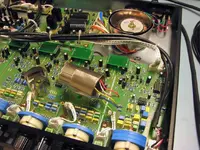J
jdbakker
New member
There's no such thing as a "ground loop". That's a total misnomer.
That's a pretty unique perspective.
On a rack level, ground loops occur when interconnected devices have different ground potentials. This can happen when neither, some or all of the affected devices are connected to mains ground. For current to flow there must be a loop; if not through mains/safety ground this often happens through common-mode capacitive coupling in the PSU transformer.
A second mechanism is induction; wherever you have a loop and a varying magnetic field you'll get a current flowing. This current, combined with non-zero impedance, means that not all points of the loop are at the same potential. This is an extremely common mechanism of both transmitted and received EMI, and a common cause of hum in DIY and (proto versions of) professional equipment. For hum, you can think of it as an extra parasitic winding on the PSU transformer, this is also one reason why there can be more/less hum when a device is racked vs. on the bench. To eliminate this, either kill the loop (as with star grounding) or minimize the loop area.
Within the context of this device, the best thing that could be done to avoid ground hum is to star ground each of the boards and slice the grounds on every jumper board, but if you star ground it with heavy enough wire, slicing the existing ground traces (which do parallel the signal traces) shouldn't make things much better at all.
The individual boards have unbalanced ground-referenced signal I/O. If you star ground each board, the current consumption fluctuations of each board multiplied by the inductance of your star grounding get added to the signal. Best case this injects both PSU noise and signal-related components (possibly overtones); worst case it turns the system into one big oscillator.
Very thick/short star ground links 'only' minimize this. To make it go away altogether, you need either ground-follows-signal (current situation), or a whole bunch of interstage transformers.
BTW, alexc on Prodigy-Pro has done some more investigations into the whole hum issue. This is a good starting point for his discoveries (which mostly match what has been found before, but there are some surprises).
JDB.







